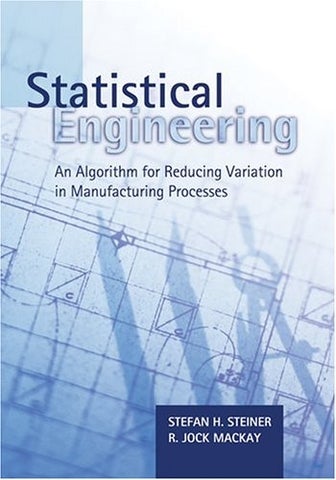
Statistical Engineering: An Algorithm For Reducing Variation In Manufacturing Processes
by Stefan Steiner, Jock MacKay
This book describes an algorithm for reducing variation in manufacturing processes. The fundamental idea is that increasing your knowledge of why and how output varies will lead to low cost process changes to permanently reduce the variation. This knowledge is generated by combining existing engineering understanding of the process with the results of carefully planned statistical investigations. Some special features of the algorithm are the use of the method elimination to find a dominant cause of variation and the explicit inclusion of variation reduction approaches such as feedback and feed-forward control, desensitization and robustness. The book provides the concepts and tools needed to work through each stage of the algorithm. There are numerous illustrative case studies and examples. An enclosed CD contains further discussion, problems, solutions, data sets and instructions for the use of MINITAB. This book will change how you think about process improvement!
Publisher: Quality Press; 1 Edition (May 2005)
Language: English
ISBN: 0873896467
Supplementary material from book CD (PDF) (pdf format, 362 pages).
Datasets from book CD (100+ datasets, compressed using 7Zip, Minitab and Excel formats).
Statistical Engineering: An Algorithm For Reducing Variation In Manufacturing Processes (PDF).
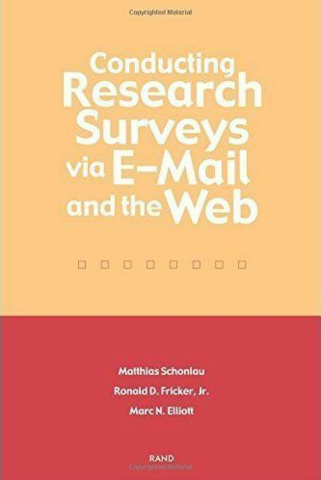
Conducting Research Surveys via E-Mail and the Web
by Matthias Schonlau, Ronald D. Jr. Fricker and Marc N. Elliott
Internet-based surveys, although still in their infancy, are becoming increasingly popular because they are believed to be faster, better, cheaper, and easier to conduct than surveys using more-traditional telephone or mail methods. Based on evidence in the literature and real-life case studies, this book examines the validity of those claims. The authors discuss the advantages and disadvantages of using e-mail and the Web to conduct research surveys, and also offer practical suggestions for designing and implementing Internet surveys most effectively. Among other findings, the authors determined that Internet surveys may be preferable to mail or telephone surveys when a list of e-mail addresses for the target population is available, thus eliminating the need for mail or phone invitations to potential respondents. Internet surveys also are well-suited for larger survey efforts and for some target populations that are difficult to reach by traditional survey methods. Web surveys are conducted more quickly than mail or phone surveys when respondents are contacted initially by e-mail, as is often the case when a representative panel of respondents has been assembled in advance. And, although surveys incur virtually no coding or data-entry costs because the data are captured electronically, the labor costs for design and programming can be high.
Publisher: RAND, Santa Monica, CA. (2002), Pp. xxiv+118.
Language: English
ISBN: 0-8330-3110-4
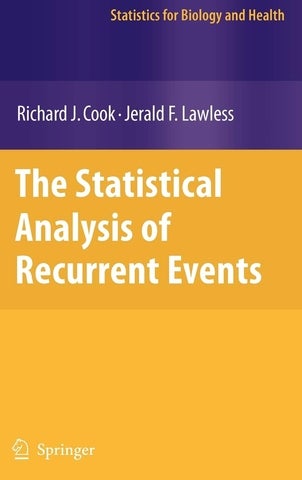
The Statistical Analysis of Recurrent Events
by Richard J. Cook, Jerald F. Lawless
Recurrent event data arise in diverse fields such as medicine, public health, insurance, social science, economics, manufacturing and reliability. The purpose of this book is to present models and statistical methods for the analysis of recurrent event data. No single comprehensive treatment of these areas currently exists. We provide broad but detailed coverage of the major approaches to analysis, while also emphasizing the modelling assumptions that they are based on. Thus, we consider important models such as Poisson and renewal processes, with extensions to incorporate covariates or random effects. More general intensity-based models are also considered, as well as simpler models that focus on rate or mean functions. Parametric, nonparametric and semiparametric methodology are all covered, with clear descriptions of procedures for estimation, testing and model checking. Important practical topics such as variations in observation schemes or selection of individuals for study, the planning of randomized experiments, events of several types and the prediction of future events are considered. Areas needing further methodologic development are noted.
Methods of modelling and analysis are illustrated through many examples taken from health research and industry. The objectives and interpretations of different analyses are discussed in detail, and issues of robustness are addressed. Statistical analysis of the examples is carried out with S-PLUS software and code is given for some examples.
This book is directed at graduate students, researchers, and applied statisticians working in industry, government or academia. Some familiarity with survival analysis is beneficial since survival software is used to carry out many of the analyses considered. This book can be used as a textbook for a graduate course on the analysis of recurrent events or as a reference for a more general course on event history analysis. Problems are given at the end of chapters, to reinforce the material presented and to provide additional background or extensions to certain topics. Extensive bibliographic notes provide references and suggestions for further reading.
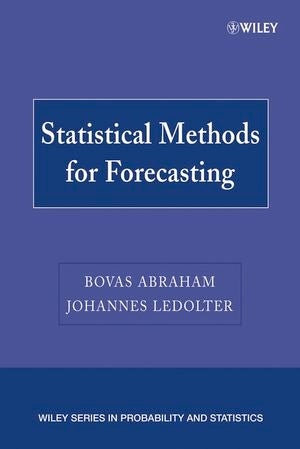
Statistical Methods for Forecasting (Wiley Series in Probability and Statistics)
by Bovas Abraham, Johannes Ledolter
Using a data-driven approach, this book is an exciting blend of theory and interesting regression applications. Students learn the theory behind regression while actively applying it. Working with many case studies, projects, and exercises from areas such as engineering, business, social sciences, and the physical sciences, students discover the purpose of regression and learn how, when, and where regression models work. The book covers the analysis of observational data as well as of data that arise from designed experiments. Special emphasis is given to the difficulties when working with observational data, such as problems arising from multicollinearity and "messy" data situations that violate some of the usual regression assumptions. Throughout the text, students learn regression modeling by solving exercises that emphasize theoretical concepts, by analyzing real data sets, and by working on projects that require them to identify a problem of interest and collect data that are relevant to the problem's solution. The book goes beyond linear regression by covering nonlinear models, regression models with time series errors, and logistic and Poisson regression models.
Publisher: Duxbury Press; 1 Edition (January 20, 2005)
Language: English
ISBN: 0534420753
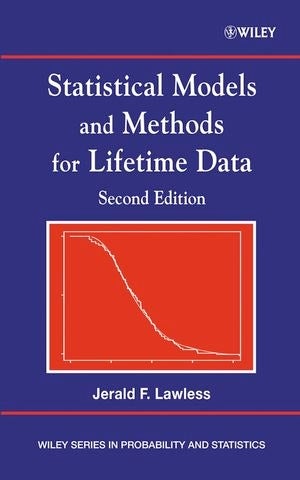
Statistical Models and Methods for Lifetime Data (Wiley Series in Probability and Statistics)
by Jerald F. Lawless
Doubling as a reference work and as a textbook for advanced students, this book provides a unified treatment of the models and methods used to analyze lifetime data. Chapters concentrate on topics like: observation schemes, censoring, and likelihood; non-parametric and graphical procedures; inference procedures for parametric models; inference procedures for log-location-scale distribution; parametric regression models; semi-parametric multiplicative hazards regression models; rank-type and other semi-parametric procedures for log- location-scale models; multiple modes of failure; goodness-of-fit tests; and, multivariate and related analyses. Key concepts are illustrated with extensive examples from engineering and the biomedical sciences.
Publisher: Wiley-Interscience; 2 Edition (November 2002)
Language: English
ISBN: 0471372153
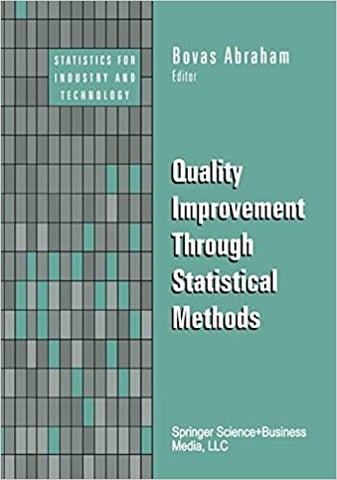
Quality Improvement Through Statistical Methods (Statistics for Industry and Technology)
by Bovas Abraham (Editor)
Brings together some of the latest statistical technology, methods and applications that emerged at an international conference in Cochin, India. DLC: Quality control - Statistical methods.
Publisher: Birkhauser; 1 Edition (May 1998)
Language: English
ISBN: 0817640525
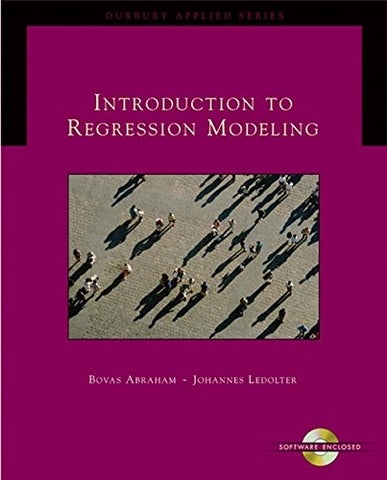
Introduction to Regression Modeling (with CD-ROM)
by Bovas Abraham, Johannes Ledolter
Presents the statistical methods and models used in the production of short-term forecasts. Deals with special topics such as transfer function analysis, Kalman filtering, state space models, Bayesian forecasting, and forecast evaluation. Explains their interconnections, and bridges the gap between theory and practice. Provides time series, autocorrelation, and partial autocorrelation plots. Includes examples and exercises using real data.
Publisher: Wiley; 1 Edition (September 1983)
Language: English
ISBN: 0471867640